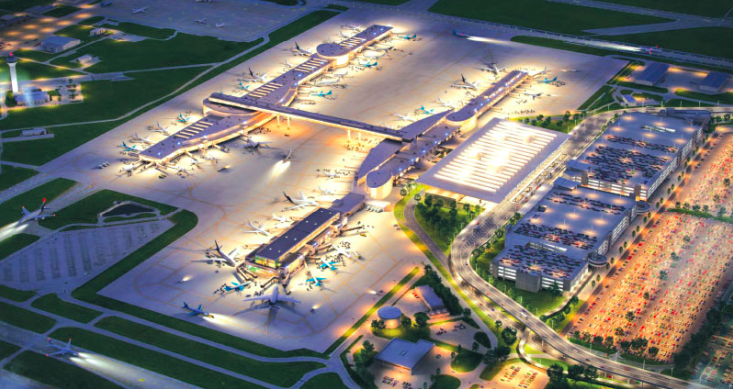Though Austin has grown to be the nation’s 11th-largest city, Austin-Bergstrom International Airport ranked 34th in departures among U.S. airports in 2017. That could be changing. ABIA’s 2040 Master Plan includes plans to expand to add 32 gates over the next two decades. Those gates, in addition to the nine new gates set to open this spring, will help bring in a projected 31 million annual passengers.

(rendering courtesy Austin Bergstrom International Airport)
Responding to tremendous population growth across its 21-county service region, a blossoming tourism industry and increasing demand, Austin’s largest airport and one of its surrounding reliever airports are investing heavily in expansion plans.
On the heels of a $350 million, nine-gate expansion set to open this spring, Austin-Bergstrom International Airport has plans to add an additional 32 gates—an evolution that would put the airport on par with Texas’ largest international airports.
“We can be as big as DFW,” said Lyn Estabrook, Planning and Development manager for ABIA, referring to the airport’s ability to handle travelers.
Austin City Council on Nov. 1 passed ABIA’s 40-year master plan after receiving a presentation two days prior. Designed in response to rapidly growing demand, the document outlines ABIA’s infrastructure map and development plans.
Out at Austin Executive Airport, a privately owned reliever airport nestled in Pflugerville’s extraterritorial jurisdiction, officials have built multiple hangars and an air traffic-control tower in the past 12 months. Those improvements came in response to and in anticipation of continually increasing demand, according to Jodie Kaluza, airport manager for Austin Executive Airport.
“We’ve seen, since opening [in 2011]to today, about a 40 percent increase in business across the board,” Kaluza said.
EXPANDING ABIA
By 2030 officials at ABIA plan to grow the airport by 20 gates, and that is excluding the ongoing nine-gate development scheduled to open this spring. Those additional 20 gates would be constructed as a separate terminal to run parallel to the existing Barbara Jordan Terminal at ABIA.
Ultimately, ABIA officials are planning to add 32 total gates by the end of 2040. The full terminal expansion will enable ABIA to handle 31 million passengers annually, Estabrook says — approximately double the number of travelers the airport currently serves.
With those gates, Estabrook states ABIA can offer more direct flights nationally and internationally.
ABIA added direct flights to Europe via British Airways, Norwegian Air Shuttle and Lufthansa in the past year alone, per Estabrook. ABIA now offers more than 80 total direct flights. The planned gate expansions will soon allow ABIA to process multiple Airbus A380s, the largest commercial airplanes in the industry, on its runways for the first time ever.
Source: Community Impact Newspaper

